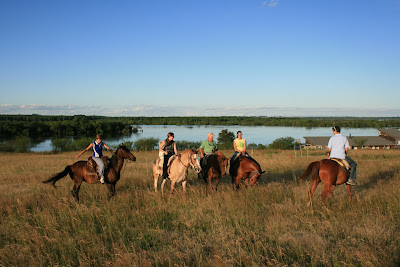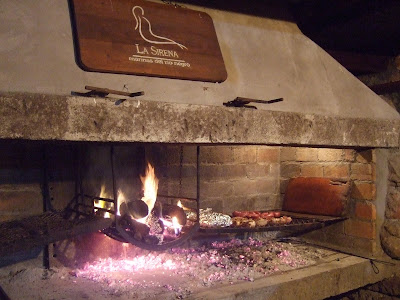 Somewhere on the Atlantic coast of Bahia lies the old Portuguese port of Porto Seguro. Across a tidal river, round and up a hill sits Arraial D'Ajuda (or “Ahhayal D'Ajewduh” as the locals seem to pronounce it). At its core, a couple of squares surrounded by brightly coloured buildings with terracotta tiled roofs. In land it breaks up into, scrub-land hallowed with the odd goal-post or horse shading under a lonely tree and then forest and field. Towards the sea it sweeps down a windy road lined with more recent developments – bar after, restaurant, after chic shop after bar – all surprisingly tasteful.
Somewhere on the Atlantic coast of Bahia lies the old Portuguese port of Porto Seguro. Across a tidal river, round and up a hill sits Arraial D'Ajuda (or “Ahhayal D'Ajewduh” as the locals seem to pronounce it). At its core, a couple of squares surrounded by brightly coloured buildings with terracotta tiled roofs. In land it breaks up into, scrub-land hallowed with the odd goal-post or horse shading under a lonely tree and then forest and field. Towards the sea it sweeps down a windy road lined with more recent developments – bar after, restaurant, after chic shop after bar – all surprisingly tasteful.
 To see why everyone is here all you have to do is walk across the oldest square, past the quintessential Latin American whitewashed church and stop and stare. At the edge of a fast falling hill, a remarkable panoramic opens up before you. Lush greenery flows forward until it meets palm-fringed golden beaches and, of course, the bright blue of the Atlantic. Quite a place to spend a few days.
To see why everyone is here all you have to do is walk across the oldest square, past the quintessential Latin American whitewashed church and stop and stare. At the edge of a fast falling hill, a remarkable panoramic opens up before you. Lush greenery flows forward until it meets palm-fringed golden beaches and, of course, the bright blue of the Atlantic. Quite a place to spend a few days.Praia after Praia
 From where you wander on to the hot sand from the village, stunning oceanic beaches stretch for mile after mile after mile. We know this first hand as on one day we walked south for 15 km or so until we reached the uber-fashionable but somehow still tranquil village of Trancoso.
From where you wander on to the hot sand from the village, stunning oceanic beaches stretch for mile after mile after mile. We know this first hand as on one day we walked south for 15 km or so until we reached the uber-fashionable but somehow still tranquil village of Trancoso. The beach is pretty damn nice near Arraial, but after a few kms it really comes into its own. Taipe is the crowning glory. A wide sweeping cove, deep expanses of soft sand sculpted by crashing waves and tide, and, best of all, backed by sandstone cliffs of red, yellow, white and purple. I should not forget the palm trees and at the far southern end, a mini peninsular of forest jutting out into the sea. Birds of prey skirt the cliff thermals.Peace and quiet – only one bar on the beach and I think we were the first customers of the day.
The beach is pretty damn nice near Arraial, but after a few kms it really comes into its own. Taipe is the crowning glory. A wide sweeping cove, deep expanses of soft sand sculpted by crashing waves and tide, and, best of all, backed by sandstone cliffs of red, yellow, white and purple. I should not forget the palm trees and at the far southern end, a mini peninsular of forest jutting out into the sea. Birds of prey skirt the cliff thermals.Peace and quiet – only one bar on the beach and I think we were the first customers of the day. Some people die for the careful lapping waves of the Med or Caribbean, but I will always be drawn to oceanic waves. Those that don't crash into reefs off shore come rolling in one after another. There is nothing like sitting there with your chilled Brazilian beer – beer on a beach is a national obsession here – and listening to the crashing and drawing of the water.
Some people die for the careful lapping waves of the Med or Caribbean, but I will always be drawn to oceanic waves. Those that don't crash into reefs off shore come rolling in one after another. There is nothing like sitting there with your chilled Brazilian beer – beer on a beach is a national obsession here – and listening to the crashing and drawing of the water.While inevitably getting loads of things wrong, most countries get some things very right. My stay here has convinced me that Brazilians get the beach better than anyone else (at least that I've met). OK, it helps if you have thousands of kms of beautiful beaches, but credit where credits due, they make beach time an art. From the already mentioned beer, via fresh tropical juice at every shack, fried cheese on a stick with oregano, a constant string of ingenious locals carrying half a shop of bikinis or hats on their person and, of course, many a form of football or footie-volley (football volleyball).
 Most importantly there is a constant undercurrent of friendly laid-back'ness. When you say no thanks to a hawker he doesn't look annoyed or pester, he shakes your hand with a smile and wanders off. People have time for a chat and chill. No hassle. Just fun, great views and slowly cooking bodies.
Most importantly there is a constant undercurrent of friendly laid-back'ness. When you say no thanks to a hawker he doesn't look annoyed or pester, he shakes your hand with a smile and wanders off. People have time for a chat and chill. No hassle. Just fun, great views and slowly cooking bodies. Christina was aghast with joy – a sea-faring ice-cream trolley...
Christina was aghast with joy – a sea-faring ice-cream trolley...
Boa Noite
 Only at night does the village of Arraial really make sense. As the heat falls and light fades, people come out from whatever shade or bit of beach they were hiding on and the place comes alive. Vibe and beats on every corner. Guitarists, drums, singers, ghetto-blasters. Hymns in the guttural Portuguese of the region pouring forth from the odd church. Stores stocking stuff I actually want to buy (havaianas and hammocks) and people watching people sipping a beer or fresh cocktail from the ladies with their portable bars. At this time of year, a census of the village would find many a laid back local, dozens of hippy-types selling hand-crafted braids and jewelery and a pretty cool crowd of sun-seekers. People congregate at the many bars and restaurants and there is an air of content.
Only at night does the village of Arraial really make sense. As the heat falls and light fades, people come out from whatever shade or bit of beach they were hiding on and the place comes alive. Vibe and beats on every corner. Guitarists, drums, singers, ghetto-blasters. Hymns in the guttural Portuguese of the region pouring forth from the odd church. Stores stocking stuff I actually want to buy (havaianas and hammocks) and people watching people sipping a beer or fresh cocktail from the ladies with their portable bars. At this time of year, a census of the village would find many a laid back local, dozens of hippy-types selling hand-crafted braids and jewelery and a pretty cool crowd of sun-seekers. People congregate at the many bars and restaurants and there is an air of content.
 Christina and I sipped our exquisite caiparinhas, fell into the rhythms of live music and realised we had fallen for Brazil.
Christina and I sipped our exquisite caiparinhas, fell into the rhythms of live music and realised we had fallen for Brazil.











 Marking the border between Argentina and Brazil, the watefalls are the result of a differential in rock causing the Rio Iguazu to gather and plummet. For over 2km, this mighty river falls in curtains of frothing water, one level after another, until it reaches the Devil's Throat. This is the gargantuan epi-centre of the waterfall, where the river falls in on itself from three sides and pulverises. Clouds of mist rise and fall. Rainbows abound.
Marking the border between Argentina and Brazil, the watefalls are the result of a differential in rock causing the Rio Iguazu to gather and plummet. For over 2km, this mighty river falls in curtains of frothing water, one level after another, until it reaches the Devil's Throat. This is the gargantuan epi-centre of the waterfall, where the river falls in on itself from three sides and pulverises. Clouds of mist rise and fall. Rainbows abound.





























